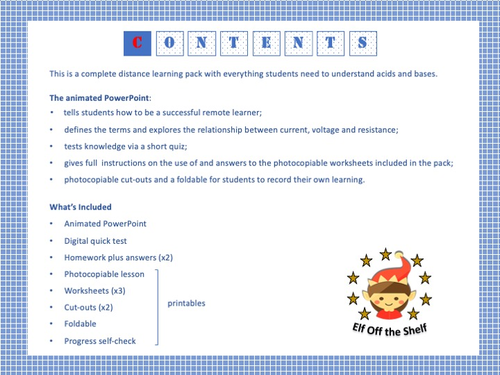











This is an action-packed distance learning or home school, fully resourced lesson on reaction of acids with metals, bases and carbonates for middle school .
This resource has been designed so that the animated PowerPoint replaces the teacher by providing structure, sequence, knowledge and answers. The worksheets, cut-outs, foldable and progress check provide a familiar medium for students to develop and test their knowledge, continue to develop their literacy skills and use their creativity to organise their learning and assess their progress.
What’s Covered
- Acids contain hydrogen.
- A salt is formed when the hydrogen of an acid is replaced by a metal.
- Hydrochloric acid forms salts called chlorides
- Sulfuric acid forms salts called sulfates.
- Nitric acid forms salts called nitrates.
- metal + acid --> a salt + hydrogen
- base + acid --> a salt + water
- alkali + acid --> a salt + water
- carbonate + acid --> a salt + water + carbon dioxide
- The first part of a salt is the metal and the second comes from the acid.
- Writing word equations for reactions between acids and metals, bases and carbonates.
Resources
- An animated PowerPoint which guides the student through the lesson by:
- explaining how to use distance learning effectively;
- explaining how to use this resource;
- explaining current, voltage and resistance and the relationship between them;
- providing the answers to all the worksheets so that the students can mark and correct their work.
-
Four worksheets, and two cut-out activities, the answers to which are in the PowerPoint.
-
A foldable and cut-out activity so that students can record and organise their learning.
-
A checklist for students to use to assess their progress.
-
Digital quick test
-
For those students without internet or a computer or a computer at home a condensed printable copy of the PowerPoint is provided for distribution by school.
Ways to Use this Resource
Upload PowerPoint and worksheets to school intranet. Students print their own worksheets.
Upload PowerPoint and worksheets to school intranet and provide a hardcopy of worksheets for students. Those families who do not wish to collect worksheets or who are in isolation can print the worksheets at home.
Students without photocopying facilities are instructed to write their answers in full sentences
More high quality resources available here.
Elf Off the Shelf Resources
Something went wrong, please try again later.
This resource hasn't been reviewed yet
To ensure quality for our reviews, only customers who have purchased this resource can review it
Report this resourceto let us know if it violates our terms and conditions.
Our customer service team will review your report and will be in touch.